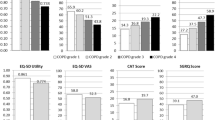Abstract
Purpose of Review
Health questionnaires are valuable tools to quantify, in an objective and standardised manner, the impact of chronic obstructive pulmonary disease on the health status of patients and on their well-being, and to track changes over time. Therefore, filling out these questionnaires allows clinicians to obtain the necessary information that can be easily related to clinical outcomes.
Recent Findings
Most importantly, symptoms’ assessment represents a very relevant part of these clinical tools when applied to patients suffering from chronic respiratory diseases. Comparing scores between visits is also indicative of the patient’s health status, as changes in quality of life are related to worse outcomes such as hospitalisation and exacerbation. However, each respiratory questionnaire may be peculiar in catching specific aspects of a similar symptom (i.e., dyspnoea); therefore, different tools are not interchangeable or comparable.
Summary
Detecting the minimal clinically important difference is a necessary evaluation procedure which affords the change in patient’s management and directs the therapeutic action towards more active treatments.
Similar content being viewed by others
References
Stephens RJ, Hopwood P, Girling DJ, Machin D. Randomized trials with quality of life endpoints: are doctors’ rating of patients’ physical symptoms interchangeable with patients’ self-ratings? Qual Life Res. 1997;6(3):225–36. https://doi.org/10.1023/A:1026458604826.
Jones PW. Health status measurement in chronic obstructive pulmonary disease. Thorax. 2001;56(11):880–7. https://doi.org/10.1136/thorax.56.11.880.
Vogelmeier CF, Criner GJ, Martinez FJ, Anzueto A, Barnes PJ, Borbeau J, et al. Global strategy for the diagnosis, management, and prevention of chronic obstructive lung disease 2017 report: GOLD executive summary. Eur Respir J. 2017;49(3):1700214. https://doi.org/10.1183/13993003.00214-2017.
Vitacca M, Paneroni M, Baiardi P, De Carolis V, Zampogna E, Belli S, et al. Development of a Barthel Index based on dyspnea for patients with respiratory diseases. Int J Chron Obstruct Pulmon Dis. 2016;11:1199–206. https://doi.org/10.2147/COPD.S104376.
Gupta N, Pinto LM, Morogan A, Borbeau J. The COPD assessment test: a systematic review. Eur Respir J. 2014;44(4):873–84. https://doi.org/10.1183/09031936.00025214.
Nishimura K, Izumi T, Tsukino M, Oga T. Dyspnea is a better predictor of 5-year survival than airway obstruction in patients with COPD. Chest. 2002;121(5):1434–40. https://doi.org/10.1378/chest.121.5.1434.
Lee SD, Huang MS, Kang J, Lin CH, Park MJ, Oh YM, et al. The COPD assessment test (CAT) assists prediction of COPD exacerbations in high-risk patients. Respir Med. 2014;108(4):600–8. https://doi.org/10.1016/j.rmed.2013.12.014.
Gale N, Albarrati A, Munnery M, Tal-Singer R, Cockcroft J, Shale D. Factors associated with COPD mortality, 2 year follow-up data from the ARCADE study. Am J Crit Care Med. 2016;193:A3526 https://tinyurl.com/yb8xbn9l (accessed 29 September 2018).
Jo YS, Yoon HI, Kim DK, Yoo CG, Lee CH. Comparison of COPD Assessment Test and Clinical COPD Questionnaire to predict the risk of exacerbation. Int J Chron Obstruct Pulmon Dis. 2018;13:101–7. https://doi.org/10.2147/COPD.S149805.
Rhee CK, Kim JW, Hwang YI, Lee JH, Jung KS, Lee MG, et al. Discrepancies between modified Medical Research Council dyspnea score and COPD assessment test score in patients with COPD. Int J Chron Obstruct Pulmon Dis. 2015;10:1623–31. https://doi.org/10.2147/COPD.S87147.
Kim S, Oh J, Kim YI, Ban HJ, Kwon YS, Oh IJ, et al. Differences in classification of COPD group using COPD assessment test (CAT) or modified Medical Research Council (mMRC) dyspnea scores: a cross-sectional analyses. BMC Pulm Med. 2013;13:35. https://doi.org/10.1186/1471-2466-13-35.
Jones PW, Adamek L, Nadeau G, Banik N. Comparisons of health status scores with MRC grades in COPD: implications for the GOLD 2011 classification. Eur Respir J. 2013;42(3):647–54. https://doi.org/10.1183/09031936.00125612.
Smid DE, Franssen FME, Gonik M, Miravitlles M, Casanova C, Cosio BG, et al. Redefining cut-points for high symptom burden of the Global Initiative for Chronic Lung Disease classification in 18,577 patients with chronic obstructive pulmonary disease. J Am Med Dir Assoc. 2017;18(12):1097.e11–1097.e24. https://doi.org/10.1016/j.jamda.2017.09.003.
Mittal R, Chhabra SK. GOLD classification of COPD: discordance in criteria for symptoms and exacerbation risk assessment. COPD. 2017;14(1):1–6. https://doi.org/10.1080/15412555.2016.1230844.
Smid DE, Franssen FM, Houben-Wilke S, Vanfleteren LE, Janssen DJ, et al. Responsiveness and MCID estimates for CAT, CCQ, and HADS in patients with COPD undergoing pulmonary rehabilitation: a prospective analysis. J Am Med Dir Assoc. 2017;18(1):53–8. https://doi.org/10.1016/j.jamda.2016.08.002.
Kon SS, Canavan JL, Jones SE, Nolan CM, Clark AL, Dickson MJ, et al. Minimum clinically important difference for the COPD Assessment Test: a prospective analysis. Lancet Respir Med. 2014;2(3):195–203. https://doi.org/10.1016/S2213-2600(14)70001-3.
Dodd JW, Hogg L, Nolan J, Jefford H, Grant A, Lord VM, et al. The COPD assessment test (CAT): response to pulmonary rehabilitation. A multicentre, prospective study. Thorax. 2011;66(5):425–9. https://doi.org/10.1136/thx.2010.156372.
Author information
Authors and Affiliations
Corresponding author
Ethics declarations
Conflict of Interest
Massimiliano Polastri, Nicolino Ambrosino, Michele Vitacca, Stefano Nava and Enrico Maria Clini declare no conflict of interest.
Human and Animal Rights and Informed Consent
This article does not contain any studies with human or animal subjects performed by any of the authors.
Rights and permissions
About this article
Cite this article
Polastri, M., Ambrosino, N., Vitacca, M. et al. Assessment of Symptoms in Patients with COPD: Strengths and Limitations of Clinical Scores. Curr Pulmonol Rep 7, 220–222 (2018). https://doi.org/10.1007/s13665-018-0217-0
Published:
Issue Date:
DOI: https://doi.org/10.1007/s13665-018-0217-0




